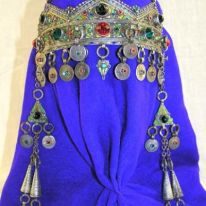
Exotic aromas of ginger, coriander, and cinnamon mingle in the streets. Fine mounds of spices tower like sand pyramids in the dusty souks of Morocco. Deep red paprika, vibrant yellow turmeric, beige sesame, green olives and lemons layer in eye catching patterns.
One of the largest markets for Moroccan spices is in Agadir. The spices are customarily displayed in metal tins, woven baskets or plastic tubs. Each dose is weighed individually and sold in a modest paper bag.
Medicinal Properties
Herb specialists in the souks have a wealth of knowledge of the medicinal benefits of the array of red, orange and yellow spices. Cumin, in between a rust and gold color, has been utilized as a stimulant, antispasmodic, carminative, sedative, digestive and also a remedy for colic and dyspeptic headaches. Saffron along with its pungent flavor and sharp odor is said to cure asthma, and some herbalists claim it contains anti-cancer properties. Cinnamon is known to have antibacterial entities and turmeric along with exhibiting strong anti-inflammatory and antioxidants also helps slow the process of food spoiling.
 Native Spices
Native Spices
While many spices were emported from the East they also originate throughout the Mediterranean and can be specifically found in Morocco. Saffron, which is often used when cooking white meats, poultry and lamb, is native from Tiliouine. Saffron is difficult to cultivate because it must be picked by hand, and for every one gram it requires 140 of the violet blue flowers. Lemons and oranges originate in Fez, and olives and mint derive from Meknes. Some other widespread spices are also home grown: cumin, cinnamon, turmeric, mint, pepper, ginger, paprika, sesame seed, anis seed, coriander, and parsley.
Dessert
Spices are the heart of Moroccan cooking, and are crucial for making a couscous or a tajine, two popular Moroccan dishes, they are also used sparingly in many desserts. Halwa shebakia, a Moroccan delicacy, is a type of honey cake. Its pretzel-like pieces of dough deep-fried and dipped into a hot pot of honey are then sprinkled with sesame seeds. The ingredients also include a teaspoon of turmeric and ground cinnamon. Saffron is also commonly used in desserts (milk, yogurt, puddings) and teas.
Mint-Tea Fresh
Not only a breath freshener, mint is also served as an herbal remedy with soothing tendencies. Traditionally while Moroccans pour their tea they raise the steaming pot high above the glass, when the tea bubbles it insures its freshness. Mint tea is also customarily served in small shots. While negotiating prices in the souks, it is common that bargainers will be offered some mint tea.






